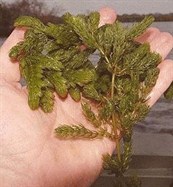
Ecological Importance
Many waterfowl species eat the shoots; it provides cover for young bluegills, perch, largemouth bass, and northern pike; supports insects that fish and ducklings eat.
Problems
|
When coontail is excessive, undesirable effects can include a reduction of open water, creation of a "scummy" appearance, limiting of desirable fishing access, interfering with boating and swimming, stunted fish and becoming invasive.
|
Plant Description:
Grows underwater with no roots; upper leaves may reach the surface; central hollow stem has stiff, dark-green leaves; plants may be long and sparse, but are often bushy near the tip, giving the plant a "coontail" or "Christmas tree" appearance. Often confused with watermilfoil, but coontail leaves are spiny and forked rather than feather-like.
Coontail, or sometimes called hornwort, is a dark olive-green, rootless submerged perennial plant that often forms dense colonies. Leaves are relatively stiff, whorled with many forks and small teeth along one edge. The tips of branches are crowded with leaves giving it a "coontail" resemblance. Coontail reproduces by seeds and fragmentation.
Hints to Identify
Often confused with watermilfoil, but coontail leaves are spiny and forked rather than feather-like.
Common Application Questions
Q. When is the best time to treat?
A. Once water temperatures are around sixty degrees or warmer and the plants are viable.
Q. How often do I need to treat Coontail?
A. Once Coontail is treated it will not grow back but adjacent populations may move back in requiring a secondary treatment
Q. How long before I see results?
A. Generally within two weeks things will be cleared up.
| Homeowner Treatment Options |
| Alligare® Diquat Herbicide |
| Aquathol® K |
| Aquathol® Super K |
| Harpoon® Granular |
| Hydrothol® Granular |
| Sonar® A.S. |
| Sonar® Ready-To-Use RTU |
| *Aquatic Biologists recommends implementing preventative maintenance techniques and physical removal prior to, or in conjunction with treatment. |
